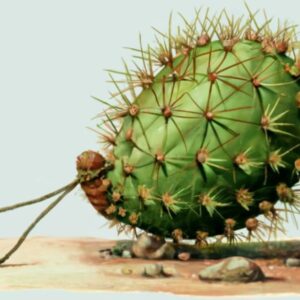In the vast tapestry of nautical history, the term “keel haul” evokes vivid imagery of maritime punishment and the stringent discipline once enforced aboard ships. But what does a “cactus keel haul” refer to? This article delves into the origins, meanings, and modern interpretations of the term, while also exploring its relevance in contemporary contexts.
Understanding the Historical Context of Keelhauling
The Practice of Keelhauling
Keelhauling, originating from the Dutch term kielhalen, refers to a brutal form of punishment where a sailor is dragged under the ship’s keel. This method was used predominantly during the 16th to 19th centuries as a means of discipline for sailors who committed serious offenses. The practice was not only a punishment but also a means of instilling fear, ensuring adherence to maritime law, and maintaining order aboard ships.
The Mechanics of Keelhauling
The procedure involved tying a sailor to a rope and dragging them underwater from one side of the ship to the other. The act could lead to severe injury or even death due to drowning, exposure to barnacles, or the ship’s propellers. While its historical accounts are grim, keelhauling serves as a reminder of the harsh realities faced by sailors of the past.
Cultural Representations
Keelhauling has been depicted in various literary and cinematic works, often romanticizing the perilous life at sea. These portrayals contribute to our understanding of maritime discipline and its cultural significance.
Introducing the Cactus Keel Haul
What is a Cactus Keel Haul?
The term “cactus keel haul” might sound unfamiliar and peculiar at first glance. In recent times, it has emerged as a metaphorical expression, blending the harshness of traditional keelhauling with the prickly nature of cacti. While not widely recognized in historical texts, the term can represent a variety of ideas, including punishment in competitive environments or the challenges faced in survival scenarios.
Symbolic Interpretation
Cacti are often associated with resilience, survival, and endurance in harsh environments. When juxtaposed with the concept of keelhauling, “cactus keel haul” may symbolize the challenges and rigorous trials one must endure to thrive in difficult situations.
The Relevance of Cactus Keel Haul Today
In Contemporary Discussions
The term “cactus keel haul” has found its way into modern vernacular, often used in discussions around tough love, accountability, and resilience. It emphasizes the importance of confronting challenges head-on and overcoming adversity, whether in personal growth, professional settings, or competitive sports.
Examples in Popular Culture
In various media, such as books, films, and social discussions, references to “cactus keel haul” can reflect the struggles faced by characters or individuals, suggesting that enduring hardship can lead to strength and growth.
Philip Cheung Wah Yan Boys: A Case Study
Understanding the Group
The Philip Cheung Wah Yan Boys, a notable group in the realm of education and community service, epitomizes resilience and dedication. This group often faces challenges similar to those symbolized by the “cactus keel haul” metaphor. Their commitment to supporting one another through trials reflects the importance of camaraderie and collective strength.
Overcoming Adversity
In many ways, the experiences of the Philip Cheung Wah Yan Boys align with the principles behind the “cactus keel haul.” Their journey often involves navigating obstacles, showcasing their ability to rise above adversity through perseverance and teamwork.
Practical Implications of the Cactus Keel Haul
Life Lessons from the Cactus Keel Haul
- Embrace Challenges: Just as a cactus thrives in arid conditions, individuals can learn to embrace their challenges, viewing them as opportunities for growth.
- Strength in Community: The importance of camaraderie, as illustrated by the Philip Cheung Wah Yan Boys, highlights how collective support can lead to overcoming shared difficulties.
- Resilience: Much like the cactus, which adapts to harsh climates, building resilience can empower individuals to face their fears and emerge stronger.
Applications in Personal and Professional Growth
The principles derived from the cactus keel haul can be applied across various aspects of life. Whether in personal development or professional environments, the ability to withstand pressure and support one another can lead to significant breakthroughs.
Conclusion
The concept of “cactus keel haul” merges historical context with contemporary symbolism, offering valuable insights into resilience, accountability, and community support. By examining the connections between past practices like keelhauling and modern interpretations, we can derive meaningful lessons applicable to today’s challenges.
FAQs about Cactus Keel Haul
What does “cactus keel haul” mean?
It is a metaphorical expression that combines the harshness of keelhauling with the resilience symbolized by cacti.
What is the origin of keelhauling?
Keelhauling originated in the 16th century as a punishment for sailors, primarily used by the Dutch.
How does the concept apply to modern life?
It emphasizes resilience, the importance of facing challenges, and the strength found in community support.
Who are the Philip Cheung Wah Yan Boys?
They are a group known for their dedication to education and community service, exemplifying resilience and teamwork.
Can the lessons from the cactus keel haul be applied in the workplace?
Yes, the principles of perseverance and collective support can enhance teamwork and personal growth in professional settings.
Is “cactus keel haul” commonly used?
While it is not widely recognized, it is gaining traction as a metaphor for overcoming challenges.
What can we learn from historical keelhauling?
It serves as a reminder of the discipline and order that were necessary aboard ships, highlighting the severe consequences of misconduct.
How do cacti symbolize resilience?
Cacti are able to thrive in harsh conditions, representing endurance and adaptability.
What other metaphors are similar to “cactus keel haul”?
Similar metaphors include “no pain, no gain” and “what doesn’t kill you makes you stronger.”
Why is community support important in facing challenges?
Collective support can provide motivation, encouragement, and practical assistance in overcoming difficulties.
This comprehensive exploration of the “cactus keel haul” serves as a rich resource for understanding its multifaceted implications, drawing connections between historical practices and contemporary life.




